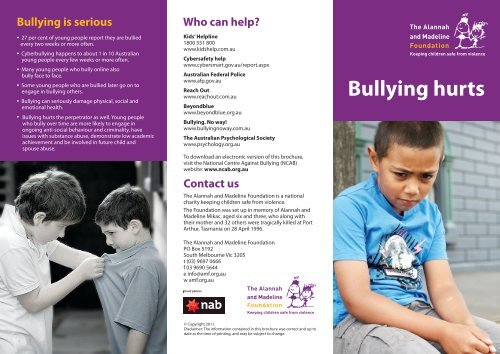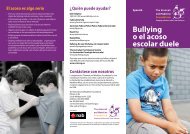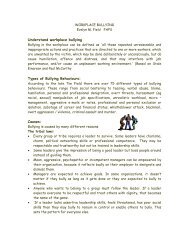Bullying Hurts brochure - The Alannah and Madeline Foundation
Bullying Hurts brochure - The Alannah and Madeline Foundation
Bullying Hurts brochure - The Alannah and Madeline Foundation
Create successful ePaper yourself
Turn your PDF publications into a flip-book with our unique Google optimized e-Paper software.
<strong>Bullying</strong> is serious<br />
• 27 per cent of young people report they are bullied<br />
every two weeks or more often.<br />
• Cyberbullying happens to about 1 in 10 Australian<br />
young people every few weeks or more often.<br />
• Many young people who bully online also<br />
bully face to face.<br />
• Some young people who are bullied later go on to<br />
engage in bullying others.<br />
• <strong>Bullying</strong> can seriously damage physical, social <strong>and</strong><br />
emotional health.<br />
•<br />
<strong>Bullying</strong> hurts the perpetrator as well. Young people<br />
who bully over time are more likely to engage in<br />
ongoing anti-social behaviour <strong>and</strong> criminality, have<br />
issues with substance abuse, demonstrate low academic<br />
achievement <strong>and</strong> be involved in future child <strong>and</strong><br />
spouse abuse.<br />
Who can help?<br />
Kids’ Helpline<br />
1800 551 800<br />
www.kidshelp.com.au<br />
Cybersafety help<br />
www.cybersmart.gov.au/report.aspx<br />
Australian Federal Police<br />
www.afp.gov.au<br />
Reach Out<br />
www.reachout.com.au<br />
Beyondblue<br />
www.beyondblue.org.au<br />
<strong>Bullying</strong>. No way!<br />
www.bullyingnoway.com.au<br />
<strong>The</strong> Australian Psychological Society<br />
www.psychology.org.au<br />
To download an electronic version of this <strong>brochure</strong>,<br />
visit the National Centre Against <strong>Bullying</strong> (NCAB)<br />
website: www.ncab.org.au<br />
Contact us<br />
<strong>The</strong> <strong>Alannah</strong> <strong>and</strong> <strong>Madeline</strong> <strong>Foundation</strong> is a national<br />
charity keeping children safe from violence.<br />
<strong>The</strong> <strong>Foundation</strong> was set up in memory of <strong>Alannah</strong> <strong>and</strong><br />
<strong>Madeline</strong> Mikac, aged six <strong>and</strong> three, who along with<br />
their mother <strong>and</strong> 32 others were tragically killed at Port<br />
Arthur, Tasmania on 28 April 1996.<br />
<strong>The</strong> <strong>Alannah</strong> <strong>and</strong> <strong>Madeline</strong> <strong>Foundation</strong><br />
PO Box 5192<br />
South Melbourne Vic 3205<br />
t (03) 9697 0666<br />
f 03 9690 5644<br />
e info@amf.org.au<br />
w amf.org.au<br />
<strong>Bullying</strong> hurts<br />
© Copyright 2011.<br />
Disclaimer: <strong>The</strong> information contained in this <strong>brochure</strong> was correct <strong>and</strong> up to<br />
date at the time of printing, <strong>and</strong> may be subject to change.
What is bullying?<br />
<strong>Bullying</strong> is when someone or a group of people with<br />
more power repeatedly <strong>and</strong> intentionally causes hurt<br />
or harm to another person or group of people who feel<br />
helpless to respond. <strong>Bullying</strong> can continue over time, is<br />
often hidden from adults <strong>and</strong> will probably continue if<br />
no action is taken.<br />
<strong>Bullying</strong> isn’t:<br />
• single episodes of social rejection or dislike<br />
• single episode acts of nastiness or spite<br />
• r<strong>and</strong>om acts of aggression or intimidation<br />
• mutual arguments, disagreements or fights.<br />
Types of bullying<br />
<strong>The</strong> Department of Education <strong>and</strong> Early Childhood<br />
Development’s Building Respectful <strong>and</strong> Safe Schools<br />
(2010) identifies four types of bullying.<br />
1. Physical bullying includes hitting, kicking, tripping,<br />
pinching <strong>and</strong> pushing or damaging property.<br />
2. Verbal bullying includes name calling, insults,<br />
teasing, intimidation, homophobic or racist remarks, or<br />
verbal abuse.<br />
3. Covert bullying is often harder to recognise <strong>and</strong> can<br />
be carried out behind the bullied person’s back. It is<br />
designed to harm someone’s social reputation <strong>and</strong>/or<br />
cause humiliation. Covert bullying includes:<br />
• lying <strong>and</strong> spreading rumours<br />
• negative facial or physical gestures, menacing or<br />
contemptuous looks<br />
• playing nasty jokes to embarrass <strong>and</strong> humiliate<br />
• mimicking unkindly<br />
• encouraging others to socially exclude someone<br />
• damaging someone’s social reputation or social<br />
acceptance.<br />
4. Cyberbullying is overt or covert bullying behaviours<br />
using digital technologies. Examples include harassment<br />
via a mobile phone, setting up a defamatory personal<br />
website or deliberately excluding someone from social<br />
networking spaces. Cyberbullying can happen at any<br />
time. It can be in public or in private, <strong>and</strong> sometimes<br />
only known to the target <strong>and</strong> the person bullying.<br />
Signs that your child<br />
might be being bullied<br />
It’s not always easy to tell if a young person is being<br />
bullied, as sometimes they don’t want to disclose what’s<br />
happening to them.<br />
If you notice a significant change in behaviour, this could<br />
be cause for concern. Other signs can include changes<br />
to mood or eating <strong>and</strong> sleep patterns; withdrawal<br />
from family, social groups or friends; decline in school<br />
performance or unwillingness to attend; lost, torn or<br />
broken belongings; scratches or bruises, or implausible<br />
excuses for any of the above.<br />
What to do if your child<br />
is bullying others<br />
• Stay calm. Remember, the behaviour is at fault, rather<br />
than the child.<br />
• Make sure your child knows bullying behaviour is<br />
inappropriate <strong>and</strong> why.<br />
• Try to underst<strong>and</strong> the reasons why your child<br />
has behaved in this way <strong>and</strong> look for ways to<br />
address problems.<br />
• Encourage your child to look at it from the other’s<br />
perspective, for example, “how would you feel if…”<br />
• Help your child think of alternative paths of action.<br />
• Provide appropriate boundaries for their behaviour.<br />
Things you can do if your<br />
child is being bullied<br />
1. Listen – Try to listen to the whole story without<br />
interrupting. Be empathic, calm <strong>and</strong> validate what is<br />
being said. Ask what your child would like to happen,<br />
before you make suggestions.<br />
2. Talk – Have a conversation about what happened.<br />
Try not to make the conversation intense or you might<br />
deter your child from talking to you. Remind your child<br />
it’s normal to feel hurt, it’s never OK to be bullied, <strong>and</strong> it’s<br />
NOT their fault.<br />
3. Find out what is happening – Note what, when <strong>and</strong><br />
where the bullying occurred, who was involved, how<br />
often <strong>and</strong> if anybody else witnessed it. Don’t offer to<br />
confront the person yourself.<br />
4. Contact the school – Check your school’s bullying<br />
policy. Find out if the school is aware of the bullying<br />
<strong>and</strong> whether anything has been done to address the<br />
situation. Make an appointment to speak to your<br />
child’s teacher or coordinator. Try to make a follow-up<br />
appointment to ensure the situation is being addressed.<br />
5. Give sensible advice – Encourage your child not<br />
to fight back, but coach them to use neutral or, if<br />
appropriate, joking language in response. Help them<br />
explore other possible responses.<br />
• Tell them that the behaviour was intentional <strong>and</strong> it<br />
won’t just go away.<br />
• Explain it’s safer to avoid people, places or situations<br />
that could expose them to further bullying.<br />
• If your child asks to stay home<br />
from school, explain that<br />
it won’t help – <strong>and</strong> may<br />
make things worse.<br />
• If possible, help to<br />
make opportunities<br />
for them to join<br />
other groups of<br />
young people<br />
– e.g. clubs at<br />
school or other<br />
groups outside<br />
of school time.









